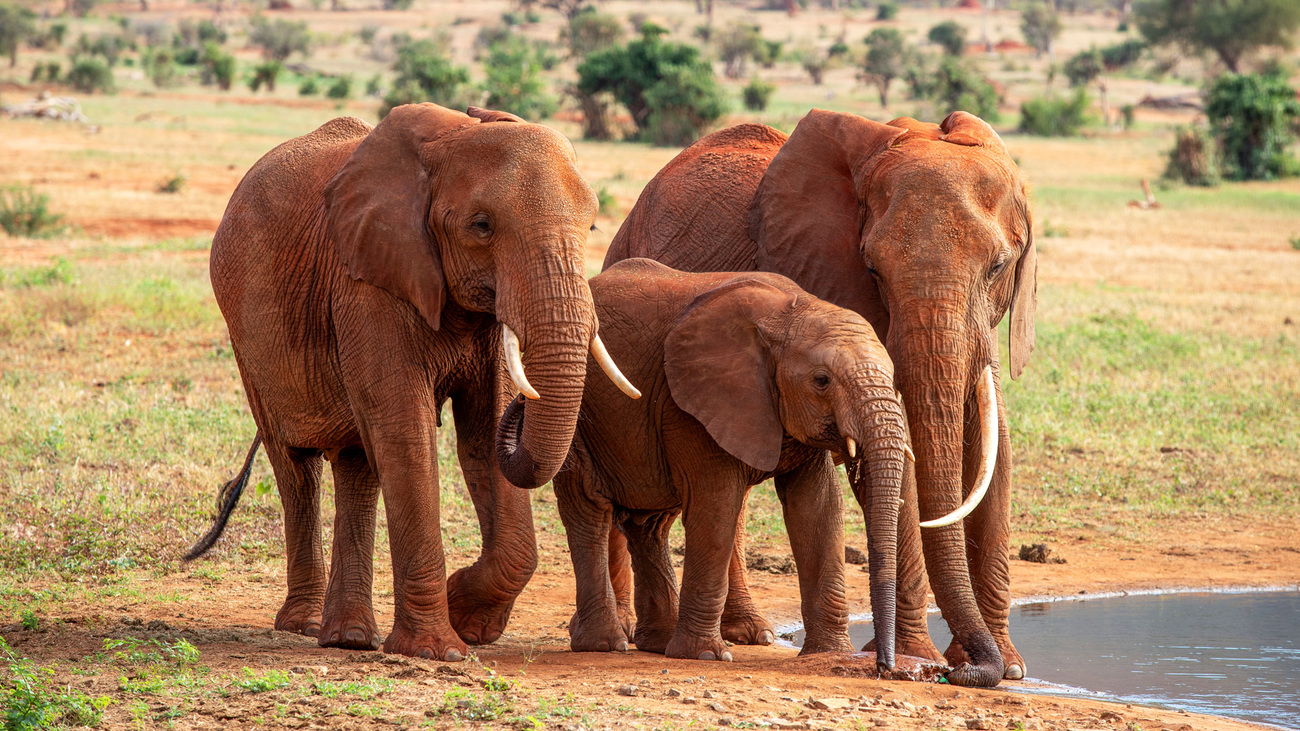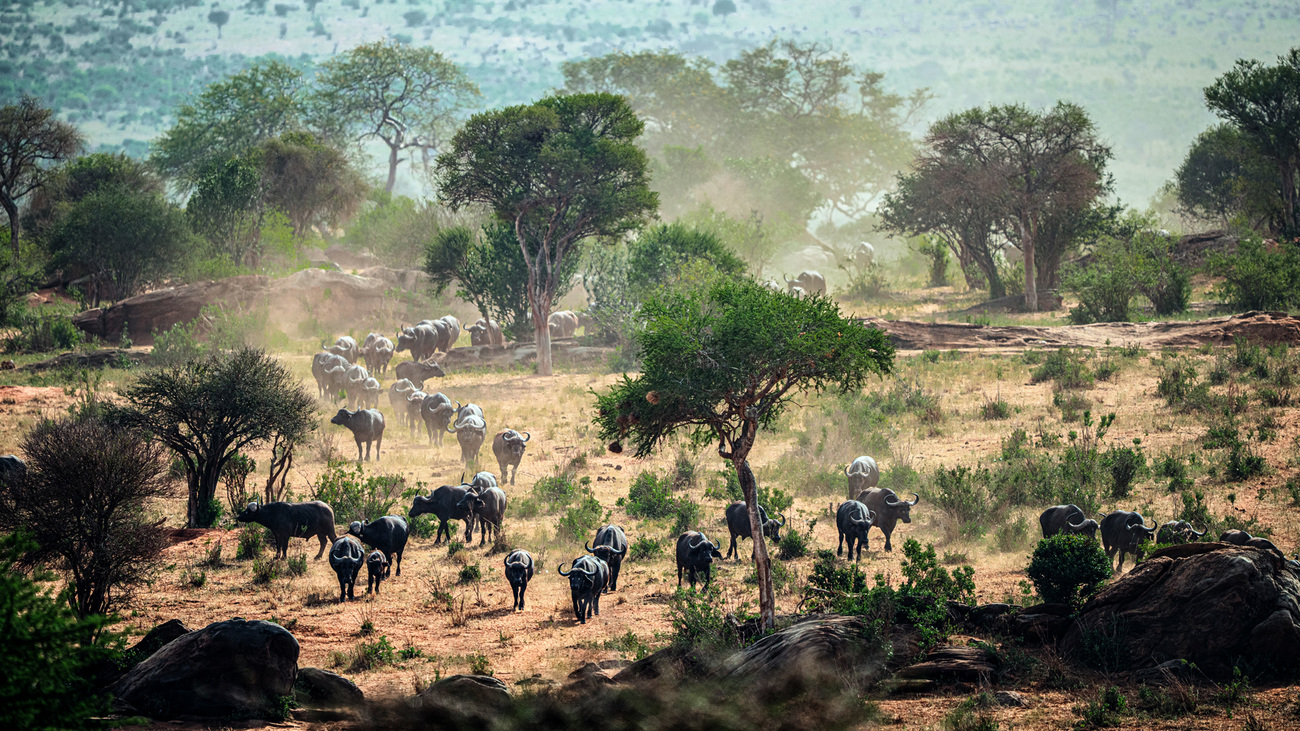Neil Greenwood
From legendary hunters to elephant keepers: How the Waata are rising from a history of marginalisation
From legendary hunters to elephant keepers: How the Waata are rising from a history of marginalisation
They are a small Indigenous community—perhaps fewer than 20,000 individuals in total, scattered by history, time, and fate across the semi-arid lands of East Africa. Labeled ‘others’ in government census records, the Waata don’t officially exist.
Except that they do, in disparate territorial groups, economically disenfranchised and politically disempowered. They eke out a living on the fringes of society as security guards, charcoal burners, suppliers of building poles in urban centres, and peasant farmers in impoverished villages like Shirango, Kenya, a settlement of 500 people kilometers off the southeastern border of Tsavo East National Park.

Yet, in days long gone, they were a proud hunter-gatherer community regarded in awe as ‘People of the Long Bow’. Their knowledge of fieldcraft, archery, plant toxins, and ability to fell elephants and other big game for the pot using only poisoned arrows enabled them to survive in the wildlife-rich scrublands of Kenya, Ethiopia, and Tanzania. They battled the elements, sustainably harvesting game for food and trading ivory and animal products for goods, the name ‘Waata’—meaning to go with the will of God—a testimony to their ability to adapt to the whims of nature.
On the fringes of society
Initially pastoralists, the community split from larger ancestral Cushitic groups due to drought-related conflicts over water and abandoned livestock for hunting and gathering. Their lifestyle was, however, halted in 1948 when the colonial government established Tsavo East National Park for wildlife protection and tourism. Relocated to a community reserve and banned from hunting, their way of life and means of livelihood were shattered at the stroke of a pen.
In the paper ‘Marginalization of the Waata Oromo Hunter-Gatherers of Kenya: Insider and Outsider Perspectives’, anthropologist Aneesa Kassam and community social activist Ali Bashuna describe a myth of origin that defined the Waata lifestyle across generations: Gifted wild animals by the Oromo Sky-God, Waaqa, together with bow, arrow, and poison-making skills, they considered wildlife their exclusive property, and hunting a divine gift—their signature weapon a double-convex longbow.
‘Unlike poachers and licensed hunters who killed elephants and rhinos for ivory and rhino horn, our people only hunted for food, harvesting only what was enough for a group of families,’ says Barisa Hiyesa Thise, a Waata community elder in Shirango village. ‘They protected wildlife because game meat was their main food.’
When they were driven out of Tsavo, many Waata failed to adapt to farming in a harsh landscape where erratic rainfall, long droughts, and crop failure are the norm. They resorted to illegal ivory trade and charcoal burning to make ends meet while others relocated to urban centres in search of menial jobs.
However, marginalization of the Waata began much earlier and was, ironically, rooted in their resilience, adaptive lifestyle, and ability to thrive in the harshest of environments. Their ethnic cousins, the Gabra and Borana who rear livestock, considered them ‘unclean’ and of lower caste. They, write Kassam and Bashuna, consumed porcupine, hippopotamus, and rhinoceros meat, which made them ‘impure’ and, therefore, they ‘must live west of all pastoralist settlements’—away from them. Other neighbouring communities christened them Waliangulu—eaters of tortoise—a slur that elicits pain to this day.
Labeled poachers and criminals by the colonial government, they were ruthlessly hunted down between 1956 and 1957, and their subsistence activities in and around the park became forbidden by law. Cornered and wrapped in stigma, they concealed their identity for fear of persecution and chose to identify themselves as part of neighbouring ethnic groups in the first national census in 1962 and those that followed. According to Kassam and Bashuna, ‘They ceased to exist as a distinct cultural entity and became socially and politically invisible.’
The Waata—a proud hunter-gatherer group that had ruled the savannah, walking gingerly through thorny bushes like the elephants with whom their livelihoods and lifestyles have been intricately tied for millennia—ceased to exist. They became ‘others’—a lost community living ‘on the fringes of society.’

Poverty, food insecurity, incessant droughts, and human-wildlife conflict
The Kenyan population of the Waata is today estimated at 2,000 to 2,500 individuals, scattered in multiple directions by hardship and the winds of time and change. Approximately only 500 individuals in 200 households remain settled on the community land in Shirango village. Not officially recognized as a tribe, they are too small a group to negotiate for political representation and socio-economic benefits from the government.
Plagued by poverty and food insecurity due to incessant droughts, water scarcity, and human-wildlife conflict, their marginalisation has been glaring since the 1950s. Unable to merit a primary school of their own due to their small population, children in Shirango village walk up to 12 kilometers daily to access education, a challenge in a wildlife-friendly zone. The community lacks land rights, too. Their over 100,000-acre ancestral spread has never been adjudicated since independence, making their ownership tenuous.
‘We need our ownership of this land formalized through adjudication so that we can, as a community, make collective, long-term and binding decisions about its use,’ says Barisa Hiyesa Thise, a Waata community elder and the Shirango Conservancy chairman.
His community inhabits one of seven villages in a wildlife-friendly zone adjacent to the Shirango Wildlife Conservancy. Hosting 300 to 500 elephants, the conservancy is a buffer on the southeastern tip of the Tsavo East National Park boundary and a migration corridor and maternity ground for elephants attracted by sufficient forage, water from earth dams, and relative safety in a community that has co-existed with wildlife for generations. Nonetheless, human-elephant conflicts—particularly those related to crop damage—arise, further impoverishing an already food-insecure community.
Solutions to conflict: fencing, clean water, and sustainable farming
Tsavo Trust, together with USAID, IFAW, and other donors, is supporting this community to overcome these challenges.
Already, wildlife-proof fences and solar-powered lighting are protecting homes and crops, enabling households to harvest and store sufficient food to last up to six months. Regular patrols and wildlife drives by community game scouts and Kenya Wildlife Service rangers have also reduced elephant density in human settlements, allowing children to walk safely to school. There are plans to build a water desalination plant as well so that the community can access clean water.
Tsavo Trust has provided a pickup truck for field patrols and facilitated the professional training of six community game scouts, enabling them to enforce wildlife regulations, monitor and protect the landscape and its biodiversity, and manage human-elephant conflict. The project has also trained local farmers to implement best practices for climate-smart agriculture in this arid land to reduce charcoal burning, logging, and bushmeat hunting as a means of livelihood during droughts; provided water tanks to households for rainwater harvesting; and met the costs of surveying the Shirango Community Conservancy land.

Ensuring genetic diversity of elephants and long-term species survival
IFAW’s experience shows that when communities like the Waata are engaged as key stakeholders, they are more likely to participate in wildlife protection programs benefitting their daily lives, even if those benefits are only indirectly linked to wildlife.
IFAW’s Room to Roam conservation model is a solution that works with the people closest to the animals and habitats we strive to protect. By collaborating with communities, NGOs, and governments to ensure greater biodiversity, and natural resilience to climate change, we create a future where animals and people can coexist and thrive.
The long-term plan is to build community and ecosystem resilience and improve governance in the community-owned Shirango Wildlife Conservancy to benefit both people and wildlife.
‘We visited conservancies in Amboseli and the Maasai Mara as part of capacity building through this project and witnessed communities reaping benefits from wildlife-based tourism,’ says Thise. ‘We want that, too.’
Conservancy manager Simeon Mwadilo describes Shirango as a unique ecosystem with endangered and endemic species, as well as an important wildlife corridor providing connectivity and room to roam for elephants between Tsavo East and West National Parks to Arabuko Forest Reserve. This connectivity is critical for genetic diversity and long-term species survival.
‘By protecting wildlife through anti-poaching patrols, restoring the habitat, reducing human-elephant conflicts, and improving food security and community resilience, we aim to promote sustainable practices and raise awareness about the importance of conservation,’ says Mwadilo.
‘It is our dream to empower the Waata—a marginalized indigenous group with profound knowledge and respect for wildlife—to better their livelihoods and become better custodians of this natural resource.’
>>> Learn more about Room to Roam
Related content
Our work can’t get done without you. Please give what you can to help animals thrive.